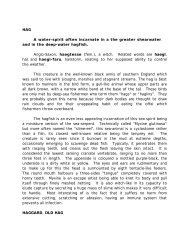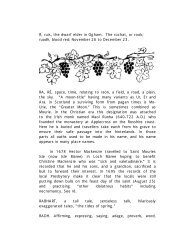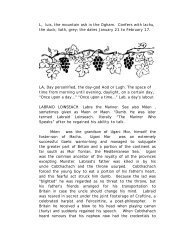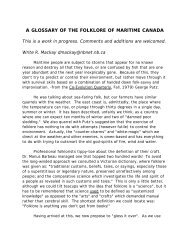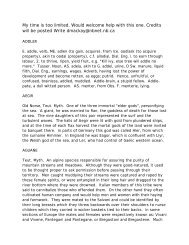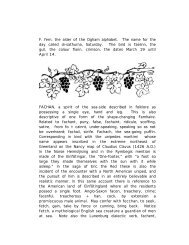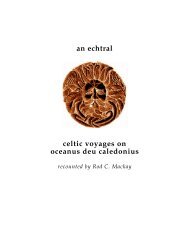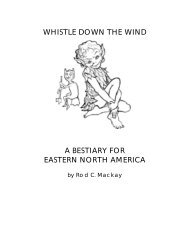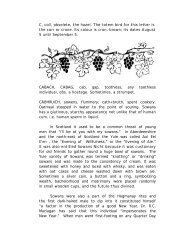G, GORT, ivy in the Ogham alphabet. The bird ... - Rodney Mackay
G, GORT, ivy in the Ogham alphabet. The bird ... - Rodney Mackay
G, GORT, ivy in the Ogham alphabet. The bird ... - Rodney Mackay
You also want an ePaper? Increase the reach of your titles
YUMPU automatically turns print PDFs into web optimized ePapers that Google loves.
GAOL, love, fondness, a beloved, a lover, Ir. gaol, k<strong>in</strong>,<br />
family, EIr. gael, a relationship, Germ. geil, wanton. See<br />
Gaifhheal, a Gael, an <strong>in</strong>habitant of <strong>the</strong> Scottish highlands.<br />
Supposedly based on <strong>the</strong> name of <strong>the</strong>ir ultimate patriarch.<br />
GAOTH, shoot<strong>in</strong>g pa<strong>in</strong>, a stitch, vanity, flatulence, from gai,<br />
also seen as vei, same as ON. ve, <strong>the</strong> w<strong>in</strong>d. Related are <strong>the</strong><br />
Gaelic gaibheach, stormy, bluster<strong>in</strong>g; gailbh<strong>in</strong>n, a storm at<br />
sea, a storm of snow; gaile, excitement; gaillionn, a w<strong>in</strong>dstorm,<br />
<strong>the</strong> Scand. galen, <strong>the</strong> English gale and ghost.<br />
<strong>The</strong> elemental gods of Scand<strong>in</strong>avia were sometimes<br />
given as Lokki (fire); Vili (water) and Ve (w<strong>in</strong>d). <strong>The</strong> latter<br />
two are represented <strong>in</strong> Teutonic myth as Hler and Kari. <strong>The</strong><br />
Gaelic fire-god was Lugh, <strong>the</strong>ir sea-god Ler and <strong>the</strong> w<strong>in</strong>dgod<br />
Meirneal, who <strong>the</strong> English called Merl<strong>in</strong>. Hence<br />
gaoistean, an crafty fellow, a “trapper,” and gaois<strong>the</strong>an, a<br />
fop, a w<strong>in</strong>d-head. <strong>The</strong> family name Vey is from this root. It<br />
has been suggested that under <strong>the</strong> will of <strong>the</strong> creator-god<br />
<strong>the</strong>y co-operated <strong>in</strong> <strong>the</strong> creation of man; <strong>the</strong> w<strong>in</strong>d-god<br />
gift<strong>in</strong>g humans with motion and <strong>the</strong> six senses. In later<br />
Norse mythology Od<strong>in</strong> is often substituted for Ve as Lord of<br />
<strong>the</strong> Nor<strong>the</strong>rn Mounta<strong>in</strong>s.<br />
It has been claimed that <strong>the</strong> bro<strong>the</strong>rs, Vili and Ve,<br />
annually usurped <strong>the</strong> power of Od<strong>in</strong>, tak<strong>in</strong>g his throne and<br />
rap<strong>in</strong>g his wife Frigga. Each May, Od<strong>in</strong> was said to return<br />
from his w<strong>in</strong>ter journeys and leadership of <strong>the</strong> Asgarderia,<br />
or Host of Soul-Catchers. F<strong>in</strong>d<strong>in</strong>g his realm reduced to<br />
unhapp<strong>in</strong>ess, he always drove off his bro<strong>the</strong>rs. Thus, <strong>the</strong><br />
w<strong>in</strong>d is a male personification of <strong>the</strong> Cailleach bheurr,<br />
similarly driven <strong>in</strong>to exile at <strong>the</strong> end of w<strong>in</strong>ter. <strong>The</strong><br />
Samha<strong>in</strong>, or May Day festivities, were partly a celebration<br />
of <strong>the</strong> failure of <strong>the</strong> w<strong>in</strong>ter-spirit. In Scand<strong>in</strong>avia, until<br />
very recent times, <strong>the</strong> May Ride was celebrated on <strong>the</strong> first<br />
day of this month. In it a flower-bedecked human<br />
representative of K<strong>in</strong>g Od<strong>in</strong> was required to drive off a furenveloped<br />
figure represent<strong>in</strong>g K<strong>in</strong>g Uller (W<strong>in</strong>ter) by pelt<strong>in</strong>g<br />
him with fresh blossomed flowers. In England this day is



